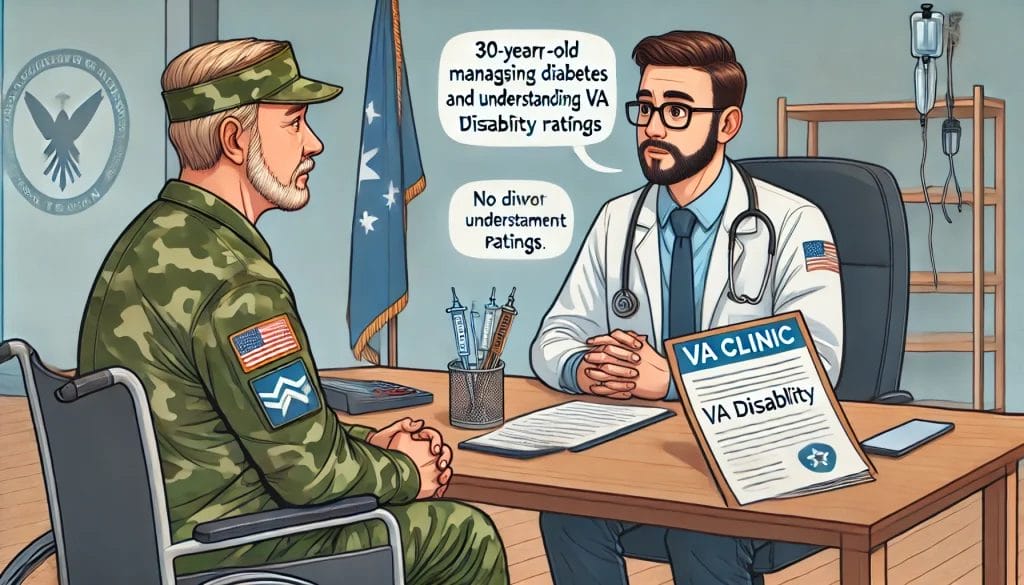Veterans diagnosed with diabetes may be eligible for VA disability benefits, particularly if their condition is connected to their military service.
The Diabetes VA rating determines how much compensation veterans can receive, based on the severity of the condition and its impact on daily life.
What is the Diabetes VA Rating?
The Diabetes VA rating is a percentage assigned by the Department of Veterans Affairs based on the severity of a veteran’s diabetes and its impact on daily life. The rating ranges from 10% to 100%, with higher ratings indicating more severe conditions and greater compensation.
Types of Diabetes Eligible for VA Ratings
- Type 1 Diabetes: Typically diagnosed early in life but may be service-connected if aggravated during active duty.
- Type 2 Diabetes: Often linked to Agent Orange exposure or other service-related factors.
- Secondary Conditions: Complications caused by diabetes, such as neuropathy or kidney disease, may be rated separately.
AI Powered Chatbot for VA Disability Claims
Learn more about the VA Disability process and get help with our VA Disability Claim Chatbot programmed and trained by AI

Diabetes VA Rating Scale
The VA uses 38 CFR § 4.119, Diagnostic Code 7913 to assign disability ratings for diabetes mellitus. Ratings are determined based on the treatment required and the impact on daily activities.
Rating Criteria for Diabetes Mellitus
- 10% Rating: Diabetes is manageable through a restricted diet without medication or insulin.
- 20% Rating: Requires oral medication or insulin once per day, along with a restricted diet.
- 40% Rating: Requires insulin injections more than once per day and a restricted diet, with regulation of activities (e.g., avoiding strenuous activities to control blood sugar levels).
- 60% Rating: Requires insulin injections, a restricted diet, regulation of activities, and evidence of complications like episodes of ketoacidosis or hypoglycemic reactions requiring hospitalization.
- 100% Rating: Requires insulin injections, restricted diet, regulation of activities, frequent hospitalizations, and progressive complications affecting other organs.
Agent Orange and diabetes can be connected connected, visit the VA’s page on Agent Orange and diabetes.

Filing a VA Disability Claim for Diabetes
If you’re filing a VA disability claim for a Diabetes VA rating, here’s how to strengthen your case for the VA rating for diabetes:
1. Gather Supporting Documentation
- Medical diagnosis and treatment records.
- Evidence of a service connection (e.g., deployment records or exposure to hazardous conditions).
- Statements from healthcare providers detailing the severity of your condition.
2. Use a Nexus Letter
A nexus letter from a medical professional connects your diabetes to your military service. This is especially critical for secondary conditions.
3. Highlight Daily Limitations
Detail how diabetes impacts your work, social life, and physical activities. Use examples like missed workdays, difficulty maintaining physical fitness, or challenges managing blood sugar levels.
4. Request a C&P Exam
The Compensation & Pension (C&P) exam evaluates the severity of your diabetes and associated conditions. Be honest and detailed about your symptoms during the exam.
Tips for Maximizing Your Diabetes VA Rating
- Monitor Secondary Conditions: Always report complications like neuropathy or vision issues to the VA.
- Document Hospitalizations: If you’ve been hospitalized due to ketoacidosis or hypoglycemia, provide evidence.
- Work with a VSO: Veteran Service Officers can assist with filing claims and gathering evidence.
Common Challenges in Receiving a Diabetes VA Rating
While many veterans successfully secure compensation, some face challenges such as:
- Insufficient Evidence: Missing medical records or lack of a service connection can lead to claim denial.
- Low Ratings: Veterans may receive a lower rating if they fail to demonstrate the regulation of activities or significant complications.
- Appeals Process: If your claim is denied, you have the right to appeal. Strengthen your appeal with additional medical evidence and expert statements.
How the VA Calculates Combined Ratings for Diabetes and Secondary Conditions
If you have multiple disabilities, the VA uses a combined rating system. For example:
- Diabetes (40%) + Peripheral Neuropathy (20%): Combined using the VA’s formula, resulting in an overall rating higher than 40% but less than 60%.
- Kidney Disease: If this condition significantly impacts your life, it may add to your overall rating.
The Diabetes VA rating system accounts for the cumulative impact of all conditions, ensuring you receive adequate compensation.
Understanding the Diabetes VA Rating
The Diabetes VA rating provides essential financial support for veterans managing this condition and its complications. Whether your diabetes is linked to Agent Orange exposure or developed during service, understanding the rating system and filing a strong claim is critical to receiving the compensation you deserve.
For additional assistance, consider consulting a Veterans Service Officer (VSO) or healthcare professional who specializes in VA disability claims. They can help you navigate the process and maximize your benefits.
